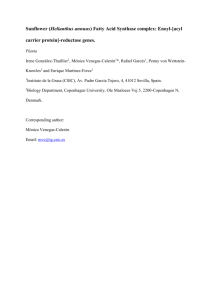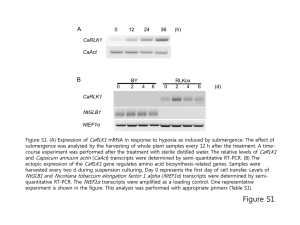prot24959-sup-0001-suppinfo
advertisement
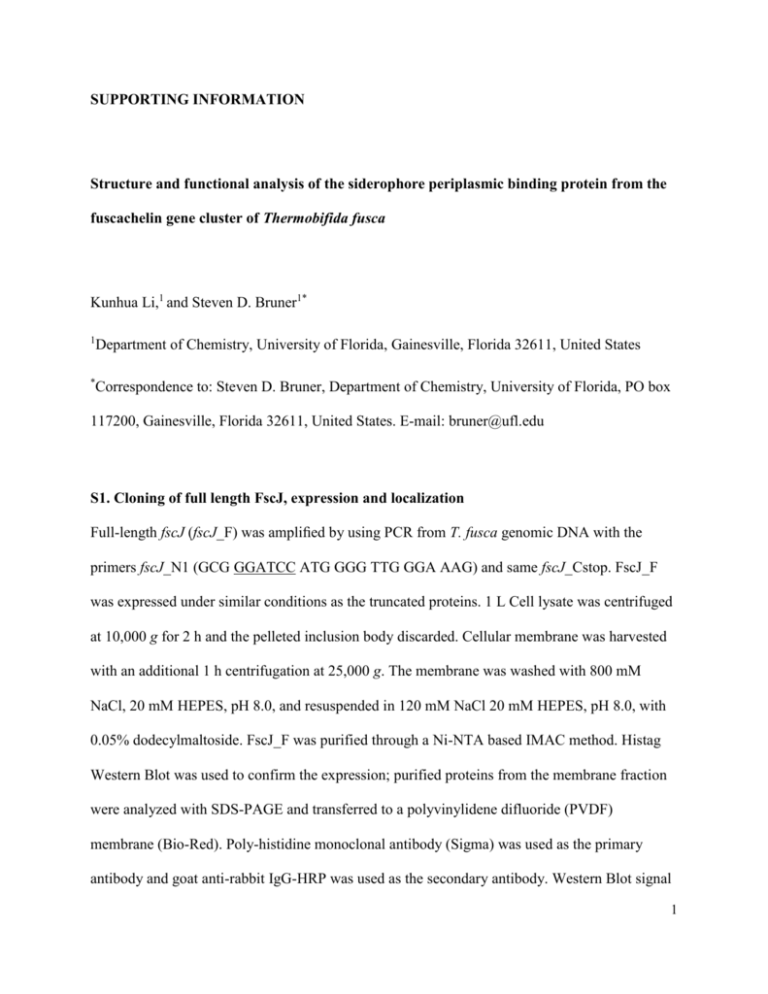
SUPPORTING INFORMATION Structure and functional analysis of the siderophore periplasmic binding protein from the fuscachelin gene cluster of Thermobifida fusca Kunhua Li,1 and Steven D. Bruner1* 1 Department of Chemistry, University of Florida, Gainesville, Florida 32611, United States * Correspondence to: Steven D. Bruner, Department of Chemistry, University of Florida, PO box 117200, Gainesville, Florida 32611, United States. E-mail: bruner@ufl.edu S1. Cloning of full length FscJ, expression and localization Full-length fscJ (fscJ_F) was amplified by using PCR from T. fusca genomic DNA with the primers fscJ_N1 (GCG GGATCC ATG GGG TTG GGA AAG) and same fscJ_Cstop. FscJ_F was expressed under similar conditions as the truncated proteins. 1 L Cell lysate was centrifuged at 10,000 g for 2 h and the pelleted inclusion body discarded. Cellular membrane was harvested with an additional 1 h centrifugation at 25,000 g. The membrane was washed with 800 mM NaCl, 20 mM HEPES, pH 8.0, and resuspended in 120 mM NaCl 20 mM HEPES, pH 8.0, with 0.05% dodecylmaltoside. FscJ_F was purified through a Ni-NTA based IMAC method. Histag Western Blot was used to confirm the expression; purified proteins from the membrane fraction were analyzed with SDS-PAGE and transferred to a polyvinylidene difluoride (PVDF) membrane (Bio-Red). Poly-histidine monoclonal antibody (Sigma) was used as the primary antibody and goat anti-rabbit IgG-HRP was used as the secondary antibody. Western Blot signal 1 was developed with SuperSignal West Pico Chemiluminescent Substrate (Thermo Forma) and detected on a KODAK RP X-OMAT film (Figure S1D). S2. FscJ SAD-MR based experimental phase improvement FscJ shares a low sequence identity compared with all other published homolog structures (Table S1) and direct molecular replacement do not yield any potential solution. FscJ has only two methionines in the total sequence of ~300 amino acids which both located on the N terminus of the protein, making standard SAD a challenge. Harvested SeMet-FscJ crystals were screened for anomalous signal and the best data set was indexed to 3.2 Å resolution in space group I222. The anomalous measurability of the data set was 0.1 at 8.3 Å resolution and 0.02 at 6.2 Å resolution from phenix.xtriage analysis. Se sites identification was initiated with phenix.hyss at 6.6 Å resolution and phases were calculated with an initial figure of merit of 0.38, which can be improved to 0.64 with density modification at 5.6 Å. A poly-alanine model was built manually into the 5.6 Å electron density map and combined model and heavy atom sites yield an interpretable 4.5 Å map from phenix.autosol. Final 3.2 Å map was achieved through combining the HA sites from 5.6 Å and model from 4.5 Å, and corresponding full-length poly-Ala model was built in Coot based on predicted protein 3D structure from Rosetta server (RMSD = 3.6 Å compare with the final structure). With a relatively low overall resolution and inaccurate phase information, the poly-alanine model can be refined to Rfree/work =0.44/0.49% and the assignment of the corresponding sidechain is rather difficult. A detailed SAD-MR strategy adapted from EMBL-Hamburg Auto-Rickshaw was used to improve the model. The Rfree value dropped below 40% after six rounds of MR-SAD (Table S3), and the resultant model was applied into molecular replacement for native data sets in higher resolution. 2 Figure S1 (A) size exclusive column purification of FscJ (with hexa-Histag). FscJ elution time is similar to proteins with molecular weight ~ 60 kDa; (B) SDS-PAGE of purified FscJ with/without hexa-Histag (left/right line) with an observed molecular weight between 43 ~ 56 kDa; (C) MALDI-TOF-MS analysis of FscJ (with hexa-Histag) provide a single mass of 35.6 kDa and; (D) SDS-PAGE and Western Blotting analysis of full-length FscJ. Figure S2 The anomalous difference map (3.0 σ contour level) calculated from (A) FscJ Se-Met data set (blue); and (B) FscJ Hg soaking data set (magenta). Hg atoms bind with His168 on the protein outer surface. 3 Figure S3 (A) Hexa-Histag stabilizes FscJ dimer interface; (B) conformation changes near central substrate binding site in F1 (light blue) and F2 (green) structures. 4 Figure S4 ITC binding analysis of purified ferric-fuscachelin A complex against hexa-Histag free FscJ. (A) wild type FscJ; (B) E279A/N280A mutant; and (C) E302A/D310A mutant. Table S1 Protein structure comparison using the Dali Server. FscJ monomer (P41-A) was used as the search model and top results are shown according to the Z-score and alignment root-meansquare deviation. (RMSD, Å) pdb Z-score RMSD lali n. res %id Siderophore (Type) 3tny-A 23.0 3.4 251 280 28 Schizokinen (Hydroxamate) 4fkm-A 21.3 3.4 247 256 19 Ferrioxamine-B (Hydroxamate) 4b8y-A 20.9 3.7 250 277 22 (Hydroxamate) 3lhs-A 20.7 3.9 258 291 21 Staphyloferrin A (Hydroxamate) 3mwf-A 20.7 3.8 250 292 26 Staphyloferrin B (Hydroxamate) 3be5-A 20.7 3.8 255 294 24 (Unknown) 3eiw-A 20.6 4.0 260 292 20 Staphyloferrin A (Hydroxamate) 5 Table S2 Primers for FscJ site-directed mutagenesis Mutant # Site(s) Primers 1 E279AN280A CAGCAGCCGGCGGGGgcggccTTCGCTGCCTTCTAC 2 E302A GTCATCTTCTACgcgACCGACGCCCAG 2 D310A CAGGAGAACCCCgccCCGTTCACCGAG Table S3 Rwork/free in FscJ MR-SAD phasing and building cycles Cycle Built resn. # (BACANNEER) Rwork/free 0 (poly-Ala) - 0.4399 / 0.4951 1 474 0.3859 / 0.4873 2 522 0.3682 / 0.4834 3 537 0.3317 / 0.4593 4 546 0.3491 / 0.4653 5 549 0.3338 / 0.4303 6 556 0.3079 / 0.3859 6
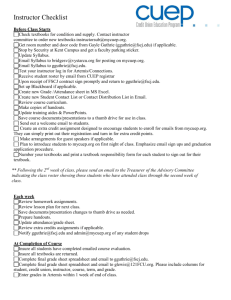
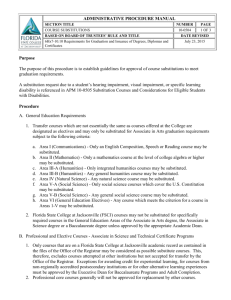
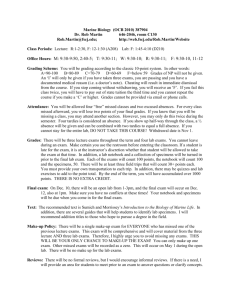
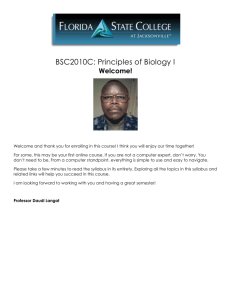
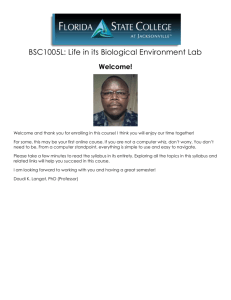

![Additional file 6. HDAC6 specific inhibitors M344 [1] Thiolate](http://s3.studylib.net/store/data/006756657_1-1db398cb64715d1936bea90dee583c4e-300x300.png)
